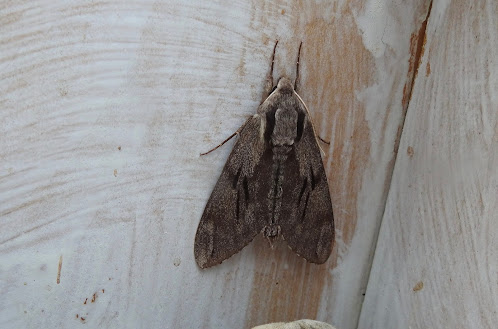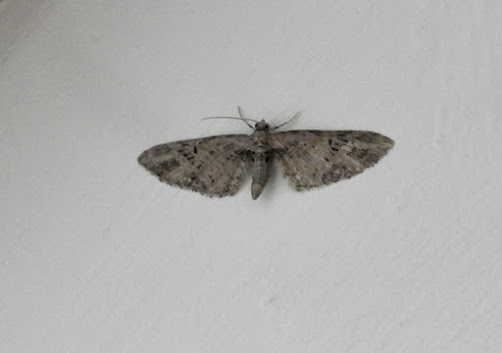I must admit that I have waited until today to add a post because birds have been hard to come by. Morton Bagot was visited today and had just about enough birds to be worth mentioning.
The highlight was a very good view of a fast moving Hobby, too fast for the camera but it was initially nice and close. The site remains a mecca for Whitethroats which seemed to be singing everywhere we went. We didn't log them, but there must have been over a dozen. Other warblers included two pairs of Willow Warblers, and two singing males each of Sedge Warbler, and Reed Warbler.
It's been a struggle to see Swift this year (I still haven't had one from the garden), but we did see two shortly after we arrived. A single male Stonechat was fly-catching from the reedbed. It was not the colour-ringed bird, so I'm guessing it is the bird from the ridge field.
 |
| Stonechat |
The rest of the story of today and the latter half of the week is very insecty.
Today, I photographed a new moth (although I didn't realise it at the time). A male long-horn moth in the hedge near the flash field turned out to be Lesser Banded Longhorn Adela croesella, and not the commoner N degeerella I had assumed it was.
 |
| Adela croesella |
I realised what it was when checking the Field Guide at home, then my old photos of degeerella, then on-line photos and finally obsidentify (which I must admit only gave it 69%, but gave degeerella 31%). I'd be disappointed if I've got it wrong.
Other insects seen were much commoner and more familiar: Mother Shipton moth, and Broad-bodied Chasers were new for the year.
 |
| Mother Shipton |
 |
| Broad-bodied Chaser |
On Friday night I put my garden moth trap out and caught 42 moths of 29 species. These included my second ever Pine Hawk-moth and second Mottled Pug for the garden.
 |
| Pine Hawk-moth |
 |
| Mottled Pug |
 |
| Alder Moth (not annual in the garden) |
The main talking point was a micro which I think was the very scarce Crassa tinctella. Views were sought, and although most were supportive there was sufficient uncertainty to render it necessary for a specimen to be taken.
 |
| Plain Bark Moth Crassa tinctella (confirmed by gen det) |
I'll find out what it is early next year when the recorder does his rounds. He also thought it might be tinctella but was glad it can be checked. He told me he has nearly 1000 records of unitella and only three of tinctella.
Going back to last Thurday, I paid a visit to Windmill Naps Wood just south of the M42. Away from the motorway it was a very nice mature oak wood but contained no unexpected birds.
 |
| Roe Deer in the wood |
I did have some interesting insects though. A micro moth was new to me, called The Minister by my latest moth guide, its latin name remains Eulia ministrana.
 |
| Eulia ministrana |
 |
| Notocelia cynosbatella (Black Cloak) other names are available |
A recent edition of the excellent Field Guide to the Micro-moths of Great Britain and Ireland is responsible for the addition of English names which often differ from previous on-line naming attempts. The confusion is a bit annoying.
Talking of new names for things, I also photographed a hoverfly which I was delighted to discover has been given the name Common Batman Fly because the pattern on its thorax is said to resemble the signal used to summon Batman.
 |
| Common Batman Fly |
Hmm, yes I can just about see what they mean.
Five months in this post that I'm yet to see 😞 Nothing much in my garden bar an early Mottled Rustic.
ReplyDeleteI'm sure there are plenty of moths on your list which I've never seen. Ever thought of writing a blog?
DeleteOn occasion, yes. But those occasions are few and far between, so there may not be many posts 😂
ReplyDeleteHi Richard, just wondering if you've managed to read the letters on the Stonechat's darvic leg ring. It looks like one of WMRG's birds.
ReplyDeleteUnfortunately I have not. Too difficult.
Delete